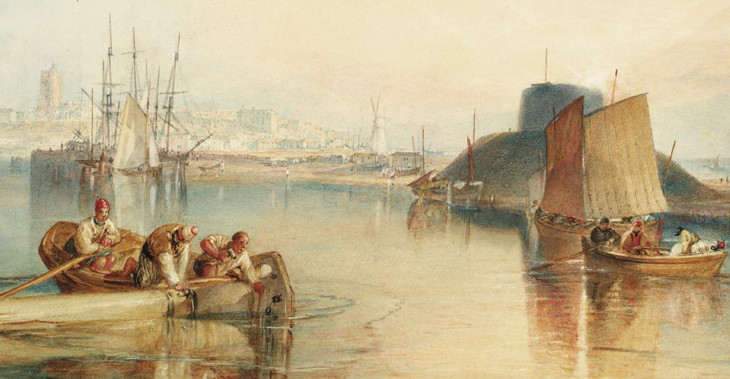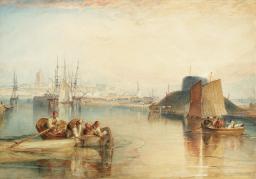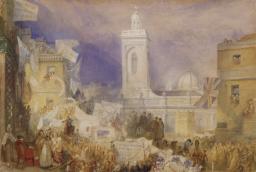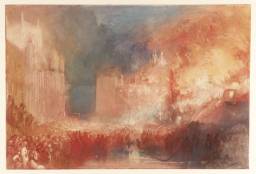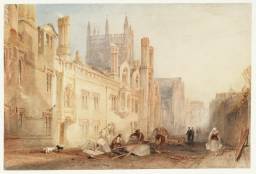From the entry
The four works grouped here are associated with certainty or near-certainty with the major series of watercolours engraved as Picturesque View in England and Wales (published 1827–38), which Andrew Wilton has described as ‘the central document in Turner’s art’. The history and significance of the published series, has been covered in great detail elsewhere, particularly by Wilton and Eric Shanes. A hundred finished watercolours were made, of which ninety-six were engraved and issued in approximately triannual parts containing four plates. They were initially commissioned by Charles Heath, who bought the finished watercolours from Turner, and exhibited them in their own right in 1829, 1831 and 1833. The publishing history is somewhat convoluted, but in effect the prints were not a financial success and the series concluded in 1838, far short of a projected one hundred and twenty designs. By then, Turner had been had been paid thirty guineas for each of ninety-seven watercolours. These ...
The four works grouped here are associated with certainty or near-certainty with the major series of watercolours engraved as Picturesque View in England and Wales (published 1827–38), which Andrew Wilton has described as ‘the central document in Turner’s art’.1 The history and significance of the published series, has been covered in great detail elsewhere, particularly by Wilton and Eric Shanes.2 A hundred finished watercolours were made, of which ninety-six were engraved and issued in approximately triannual parts containing four plates.3 They were initially commissioned by Charles Heath, who bought the finished watercolours from Turner, and exhibited them in their own right in 1829, 1831 and 1833. The publishing history is somewhat convoluted, but in effect the prints were not a financial success and the series concluded in 1838, far short of a projected one hundred and twenty designs. By then, Turner had been had been paid thirty guineas for each of ninety-seven watercolours.
These ninety-seven include the one completed and published England and Wales watercolour in the main Tate Collection: Aldborough, Suffolk (i.e. Aldeburgh), painted in about 1826 (Tate N05236),4 and engraved in 1827 (Tate impressions: T04521, T04522, T06076). Another of similar status is The Northampton Election, 6 December 1830 of about 1830–1 (Tate T12321),5 although this was not engraved, perhaps to avoid political controversy.6 The same may apply to The Burning of the Houses of Parliament of about 1834–5 (Tate D36235; Turner Bequest CCCLXIV 373), which Turner retained, although its relative lack of detail may indicate that it is not resolved anyway.
Merton College, Oxford, of about 1835–8 (Tate D25472; Turner Bequest CCLXIII 349),7 was completed but not engraved, and may have been made too late to be included; it is the only unequivocally finished topographical work in England and Wales mode to have remained in Turner’s studio and thus the Turner Bequest. Another finished watercolour, Lichfield, of about 1832 (private collection),8 was not engraved, although its format suggests it was produced for the series (see under Tate D25215; Turner Bequest CCLXIII 93).
Over a hundred ‘colour beginnings’ which can be related to the project with varying degrees of confidence are addressed by the present author in the separate ‘England and Wales Colour Studies c.1825–39’ section of the present catalogue.
For a concise account, see Eric Shanes, ‘England and Wales, Picturesque Views in’ in Evelyn Joll, Martin Butlin and Luke Herrmann (eds.), The Oxford Companion to J.M.W. Turner, Oxford 2001, pp.87–9; for the ninety-seven commissioned watercolours see Wilton 1979, pp.391–403 nos.785–881; see also the chapter ‘England and Wales’ in ibid., pp.173–92; Eric Shanes, Turner’s Picturesque Views in England and Wales 1825–1838, London 1979, including an introduction by Wilton; Eric Shanes, ‘New Light on the “England and Wales” Series’, Turner Studies, vol.4, no.1, Summer 1984, pp.52–4; and Eric Shanes, Turner’s England 1810–38, London 1990, pp.13, 162–260, 273–7.
How to cite
Matthew Imms, ‘‘Picturesque Views in England and Wales’ Watercolours c.1826–38’, June 2016, in David Blayney Brown (ed.), J.M.W. Turner: Sketchbooks, Drawings and Watercolours, Tate Research Publication, February 2017, https://www

